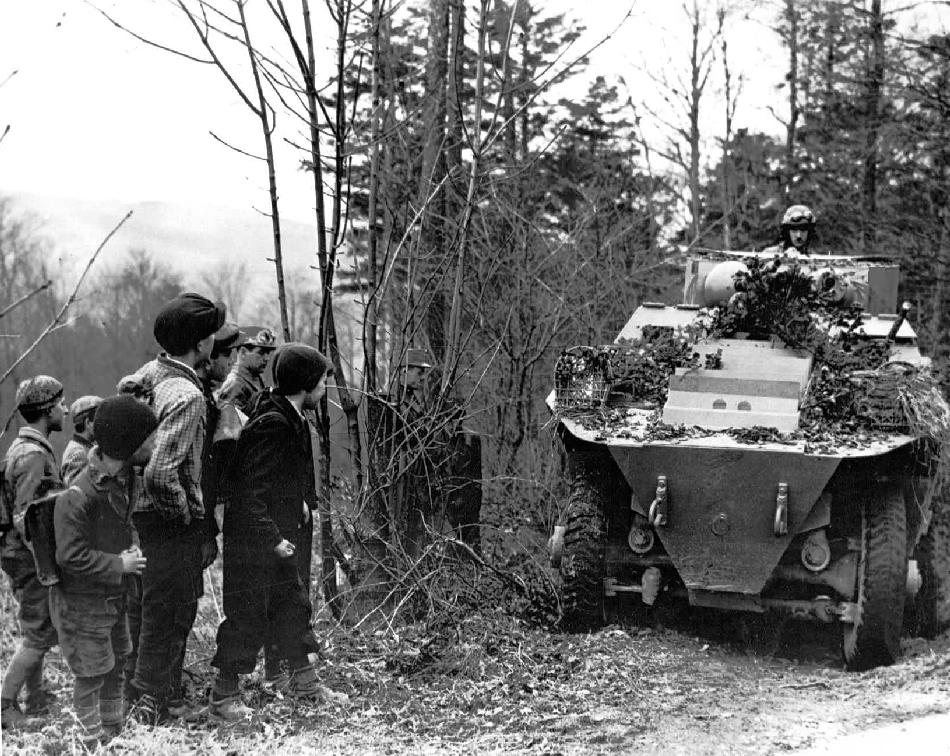
Austrian Republic (1918-38)

Figure 1.--The Austrian Republic established after World War I was a very small country with a very small industrial base, The Bundesheer not only did not have the capability of resisting a German invasion, but as much of the population favored union with Germany, the country did not have the will to resist. Here Austrian school children look over one of their country's tanks. The press caption read, "Youths Show Interest in War Machines: Eagerly these Austrian school children stop on their way to school to examine a motorized tank partially masked for forest service in Austrian war 'games'. Elaborate defensive maneuvers were underway as spring brought warmer weather. The photograph was dated April 1, 1937. Actually it was not a tank bcause it on wheels not on treads. It is a PzKpfw Steyr ADGZ Armored Car
An interesting feature of this vehicle was that there was no 'rear'. Either end was capable of driving the unit.
It was developed as a heavy armored car for the Austrian Army in 1934 and delivered during 1935-37. When the NAZIs annexed Austria through the Anschluss in 1938, they obtained 27 of these units when they incorporated the Austrian Army in the Whermacht.
|
|
Austria for several centuries was one of the major European powers, dominating much of Germany and after the Austro-Prussian War (1866) the center of a large-multi-ethnic empire as a dual monarchy with Hungary. The Austro-Hungarian Empire disintegrated in the closing months of World War I (1918). The Central Power's defeat in World War I left Austria a small, Germanic state and European backwater. Many Austrians found this a difficult adjustment to make. The Austrians declared a republic and Emperor Karl was forced to abdicate. Austria was now the much reduced territory of German-speaking Austria. The Republic of Austria was forced to recognize the independent states of Czechoslovakia, Poland, Hungary and Yugoslavia as part of the World War I settlement. It was not just a nationalist adjustment. The Austrian economy suffered with the separation from the former territories of the Empire. This
helped engender political and economic strife. The political and economic dislocation gave rise to fascism as it did in several other European countries. Many Austrians after the War wanted to join Germany, but the Allies specifically prohibited this in the Versailles Treaty (1919). This was a perfect breeding ground for fascism and the Heimwehr was one manifestation of this. The Heimwehr, similar to the German Frei-Korps, was used to suppress left-wing groups and striking workers. Austrians also elected Fascist leaders. The Heimwehr merged into the Fatherland Front (1934). Austrian fascists were divided as to whether the country should join Germany. Some were more committed to Austrian than German nationalism. After Hitler's seizure of power in Germany, the Austrian NAZI Party grew in membership, but was restricted by the Government, especially after the assassination of Chancellor Dolfuss (1934). The Austro-Hungarian Army was disbanded at the end of World War I. The Austrian Repub
lic organized a small army. At first the primary force was the Volkswehr (People's Defence Force), similar to the German Frei Korps (1918-21). They fought the Yugoslavian Army units occupying parts of Carinthia. The Army was rechristened the Bundesheer (1921). The Bundesheer suppressed an attempted NAZI take over, sometimes referred to as the Austrian Civil War (1934). The Bundesheer was a small, poorly equipped force. It developed a defense plan to resist a German invasion (1938). Unlike Czechoslovakia which was capable of resisting and had the will to do so, the Bundesheer not only did not have the capability of resisting a German invasion, but as much of the population favored union with Germany, the country did not have the will to resist.
The Austrians NAZIs led by by Arthur Seyss-Inquart, (the future NAZI occupation head in the Netherlands) agitated for union with Germany. Chancellor Kurt Schuschnig attempted to obtain foreign support. When none was forth coming from the Allies, he attempted to organize a referendum. Hitler and Göring intimidated Schuschnig from further resistance. He resigned to avoid bloodshed. Hitler finally accomplished union with the Anschluss (March 1938) which was accompanied with an explosion of national rejoicing and unimaginably vicious outburst of violence against Austrian Jews.
CIH --WW II

Navigate the CIH World War II Section:
[Return to Main World War II Austrian country page]
[Return to Main World War II country page]
[Return to Main Austrian history page]
[Biographies]
[Campaigns]
[Children]
[Countries]
[Deciding factors]
[Diplomacy]
[Geo-political crisis]
[Economics]
[Home front]
[Intelligence]
[POWs]
[Resistance]
[Race]
[Refugees]
[Technology]
[Bibliographies]
[Contributions]
[FAQs]
[Images]
[Links]
[Registration]
[Tools]
[Return to Main World War II page]
[Return to Main war essay page]
Created: 6:39 AM 3/13/2014
Spell checked: 5:38 PM 3/13/2014
Last updated: 5:39 PM 3/13/2014



